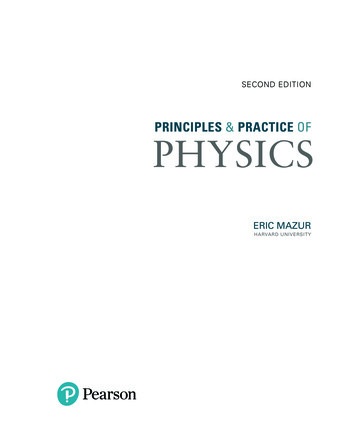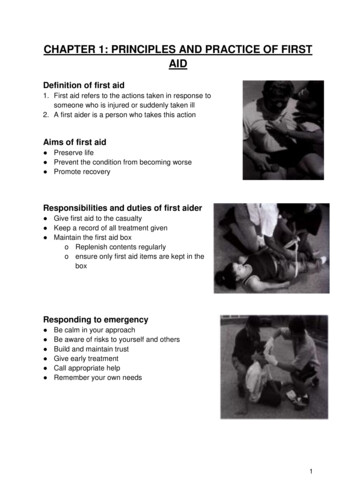
Transcription
SECOND EDITIONPRINCIPLES & PRACTICE OFPHYSICSERIC MAZURHARVARD UNIVERSITYA01 MAZU0862 02 SE FM.indd 125/01/20 12:22 PM
Please contact https://support.pearson.com/getsupport/s/ with any queries on this contentCover Image by Benjamin Lee / EyeEm / GettyImagesCopyright 2021, 2015 by Pearson Education, Inc. or its affiliates, 221 River Street, Hoboken, NJ 07030. All Rights Reserved. Manufactured in the United States of America. Thispublication is protected by copyright, and permission should be obtained from the publisherprior to any prohibited reproduction, storage in a retrieval system, or transmission in anyform or by any means, electronic, mechanical, photocopying, recording, or otherwise. Forinformation regarding permissions, request forms, and the appropriate contacts within thePearson Education Global Rights and Permissions department, please visit www.pearsoned.com/permissions/.Acknowledgments of third-party content appear on the appropriate page within the text oron page ix, which constitutes an extension of this copyright page.PEARSON, ALWAYS LEARNING, and MYLAB are exclusive trademarks owned by PearsonEducation, Inc. or its affiliates in the U.S. and/or other countries.Unless otherwise indicated herein, any third-party trademarks, logos, or icons that mayappear in this work are the property of their respective owners, and any references to thirdparty trademarks, logos, icons, or other trade dress are for demonstrative or descriptivepurposes only. Such references are not intended to imply any sponsorship, endorsement,authorization, or promotion of Pearson’s products by the owners of such marks, or any relationship between the owner and Pearson Education, Inc., or its affiliates, authors, licensees,or distributors.Library of Congress Cataloging-in-Publication DataNames: Mazur, Eric, author.Title: Principles & practice of physics / Eric Mazur, Harvard University.Other titles: Principles and practice of physicsDescription: Second edition. Boston : Pearson Education, Inc, [2021] Includes index. Summary: "Introduction of Physics with conservationlaws, emphasis on the concept of systems, postponement of vectors,integration of modern physics and more"-- Provided by publisher.Identifiers: LCCN 2019056836 ISBN 9780135610862 (student edition) ISBN9780136684879 (instructor’s review edition) ISBN 9780135611036(loose-leaf print offer edition)Subjects: LCSH: Physics--Textbooks.Classification: LCC QC21.3 .M39 2021 DDC 530--dc23LC record available at CodeISBN-10: 0-135-61088-5; ISBN-13: 978-0-135-61088-6 (Access Code Card)ISBN-10: 0-135-61086-9; ISBN-13: 978-0-13561086-2 (Rental)ISBN-10: 0-136-68487-4; ISBN-13: 978-0-13668487-9 (Instructor’s Review Copy)A01 MAZU0862 02 SE FM.indd 225/01/20 12:22 PM
Brief ContentsVolume 1 of Principles & Practice of Physics includes Chapters 1–21. Volume 2 of Principles & Practice of Physicsincludes Chapters 22–34.1CHAPTER 2CHAPTER 3CHAPTER 4CHAPTER 5CHAPTER 6CHAPTER 7CHAPTER 8CHAPTER 9CHAPTER 10CHAPTER 11CHAPTER 12CHAPTER 13CHAPTER 14CHAPTER 15CHAPTER 16CHAPTER 17CHAPTER 18CHAPTER 19CHAPTER 20CHAPTER 21CHAPTER 22CHAPTER 23CHAPTER 24CHAPTER 25CHAPTER 26CHAPTER 27CHAPTER 28CHAPTER 29CHAPTER 30CHAPTER 31CHAPTER 32CHAPTER 33CHAPTER 34CHAPTERFoundations 1Motion in One DimensionAcceleration3568Momentum98Energy 131Principle of RelativityInteractionsForce228Work264158193Motion in a Plane296Motion in a Circle333Torque370Gravity407Special Relativity443Periodic Motion486Waves in One Dimension521Waves in Two and Three DimensionsFluidsEntropy562598646Energy Transferred ThermallyDegradation of EnergyElectric InteractionsThe Electric FieldGauss’s Law683724765795827Work and Energy in ElectrostaticsCharge Separation and StorageMagnetic Interactions860890923Magnetic Fields of Charged Particles in MotionChanging Magnetic FieldsChanging Electric FieldsElectric Circuits95899310241061Electronics1103Ray Optics1146Wave and Particle Optics1189iiiA01 MAZU0862 02 SE FM.indd 325/01/20 12:22 PM
About the AuthorEric Mazur is the Balkanski Professor of Physics and Applied Physicsat Harvard University, Area Chair of Applied Physics, and a member of the faculty of Education at the Harvard Graduate School ofEducation. Dr. Mazur is a renowned scientist and researcher in opticalphysics and in education research, and a sought-after author and speaker.Dr. Mazur joined the faculty at Harvard shortly after obtaining hisPh.D. at the University of Leiden in the Netherlands. He was awardedHonorary Doctorates from the École Polytechnique and the Universityof Montreal, the Universidad Nacional Mayor de San Marcos in Lima,Peru, and the Katholieke Universiteit Leuven in Belgium. Dr. Mazur holdshonorary professorships at the Institute of Semiconductor Physics of theChinese Academy of Sciences in Beijing, the Institute of Laser Engineeringat the Beijing University of Technology, the Beijing Normal University,Sichuan University, and Nanjing University of Science and Technology.He is a Member of the Royal Academy of Sciences of the Netherlands anda Member of the Royal Holland Society of Sciences and Humanities. In2014, Dr. Mazur became the inaugural recipient of the Minerva Prize, andin 2018 he received the inaugural International Flipped Learning Awardfrom the American Academy of Learning Arts and Sciences.Dr. Mazur has held appointments as Visiting Professor or DistinguishedLecturer at Carnegie Mellon University, the Ohio State University, thePennsylvania State University, Princeton University, Vanderbilt University,Hong Kong University, the University of Leuven in Belgium, and NationalTaiwan University in Taiwan, among others. From 2015–2017 Dr. Mazurserved as Vice-President, President-Elect, and President of the OpticalSociety.In addition to his work in optical physics, Dr. Mazur is interested ineducation, science policy, outreach, and the public perception of science.In 1990, he began developing Peer instruction, a method for teachinglarge lecture classes interactively. This teaching method has developed alarge following, both nationally and internationally, and has been adoptedacross many science disciplines.Dr. Mazur is author or co-author of over 300 scientific publicationsand holds three dozen patents. He has also written on education and isthe author of Peer Instruction: A User’s Manual (Pearson, 1997), a bookthat explains how to teach large lecture classes interactively. In 2006, hehelped produce the award-winning DVD Interactive Teaching. He is theco-founder of Learning Catalytics, a platform for promoting interactiveproblem solving in the classroom, and of Perusall, the first truly AI-drivensocial learning platform.ivA01 MAZU0862 02 SE FM.indd 425/01/20 12:22 PM
To the StudentLet me tell you a bit about myself.I always knew exactly what I wanted to do. It justnever worked out that way.When I was seven years old, my grandfather gave mea book about astronomy. Growing up in the Netherlands I became fascinated by the structure of the solarsystem, the Milky Way, the universe. I remember struggling with the concept of infinite space and asking endless questions without getting satisfactory answers. Ideveloped an early passion for space and space exploration. I knew I was going to be an astronomer. In highschool I was good at physics, but when I entered university and had to choose a major, I chose astronomy.It took only a few months for my romance with theheavens to unravel. Instead of teaching me about themysteries and structure of the universe, astronomy hadbeen reduced to a mind-numbing web of facts, fromdeclinations and right ascensions to semi-major axesand eccentricities. Disillusioned about astronomy,I switched majors to physics. Physics initially turnedout to be no better than astronomy, and I struggledto remain engaged. I managed to make it through mycourses, often by rote memorization, but the beauty ofscience eluded me.It wasn’t until doing research in graduate school thatI rediscovered the beauty of science. I knew one thingfor sure, though: I was never going to be an academic.I was going to do something useful in my life. Justbefore obtaining my doctorate, I lined up my dreamjob working on the development of the compact disc,but I decided to spend one year doing postdoctoralresearch first.It was a long year. After my postdoc, I accepted ajunior faculty position and started teaching. That’swhen I discovered that the combination of doingresearch—uncovering the mysteries of the universe—andteaching—helping others to see the beauty of the universe—is a wonderful combination.When I started teaching, I did what all teachersdid at the time: lecture. It took almost a decade todiscover that my award-winning lecturing did formy students exactly what the courses I took in college had done for me: It turned the subject that Iwas teaching into a collection of facts that my students memorized by rote. Instead of transmitting thebeauty of my field, I was essentially regurgitatingfacts to my students.When I discovered that my students were not mastering even the most basic principles, I decided to completely change my approach to teaching. Instead oflecturing, I asked students to read my lecture notes athome, and then, in class, I taught by questioning—byasking my students to reflect on concepts, discuss inpairs, and experience their own “aha!” moments.Over the course of more than twenty years, the lecture notes have evolved into this book. Consider thisbook to be my best possible “lecturing” to you. Butinstead of listening to me without having the opportunity to reflect and think, this book will permit you topause and think; to hopefully experience many “aha!”moments on your own.I hope this book will help you develop the thinkingskills that will make you successful in your career. Andremember: your future may be—and likely will be—very different from what you imagine.I welcome any feedback you have. Feel free to sendme email or tweets.I wrote this book for you.Eric Mazur@eric mazurmazur@harvard.eduCambridge, MAvA01 MAZU0862 02 SE FM.indd 525/01/20 12:22 PM
To the InstructorAs you may recall from the first edition of this book,the idea of using conservation principles derived froma conversation with a dear friend and colleague, AlbertAltman, professor at the University of Massachusetts, Lowell, who asked me if I was familiar with theapproach to physics taken by Ernst Mach.Mach treats conservation of momentum before discussing the laws of motion. It involves direct experimental observation, which appealed to me. Hisformulation of mechanics had a profound influence onEinstein. Most physicists never use the concept of forcebecause it relates only to mechanics. It has no rolein quantum physics, for example. The conservationprinciples, however, hold throughout all of physics.In that sense they are much more fundamental thanNewton’s laws. Furthermore, conservation principlesinvolve only algebra, whereas Newton’s second law isa differential equation.Physics education research has shown that the concept of force, where most physics books begin, isfraught with pitfalls. What’s more, after tediouslyderiving many results using kinematics and dynamics,most physics textbooks show that you can derive thesame results from conservation principles in just one ortwo lines. Why not do the easy way first?In this edition Principles and Practice of Physics,I start with conservation of both momentum and energy,and later bring in the concept of force. The approach ismore unified and modern—the conservation principlesare the theme that runs throughout this entire book.Additional motives for writing this text came frommy own teaching. Most textbooks focus on the acquisition of information and on the development of procedural knowledge. This focus comes at the expenseof conceptual understanding or the ability to transfer knowledge to a new context. As explained below,I have structured this text to redress that balance. Ialso have drawn deeply on the results of physics education research, including that of my own researchgroup.Organization of this bookAs I considered the best way to convey the conceptual framework of mechanics, it became clear that thestandard curriculum needed rethinking. For example,standard texts are forced to redefine certain conceptsmore than once—a strategy that we know befuddlesstudents. (Examples are work, the standard definitionof which is incompatible with the first law of thermodynamics, and energy, which is redefined when modern physics is discussed.)Another point that has always bothered me is thearbitrary division between “modern” and “classical”physics. In most texts, the first thirty-odd chapterspresent physics essentially as it was known at the endof the 19th century; “modern physics” gets tackedon at the end. There’s no need for this separation.Our goal should be to explain physics in the way thatworks best for students, using our full contemporaryunderstanding. All physics is modern!That is why my table of contents departs from the“standard organization” in the following specific ways.Emphasis on conservation laws. As mentioned earlier,this book introduces the conservation laws early andtreats them the way they should be: as the backbone ofphysics. The advantages of this shift are many. First, itavoids many of the standard pitfalls related to the conceptof force, and it leads naturally to the two-body characterof forces and the laws of motion. Second, the conservation laws enable students to solve a wide variety of problems without any calculus. Indeed, for complex systems,the conservation laws are often the natural (or only) wayto solve problems. Third, the book deduces the conservation laws from experimental observations, helping tomake clear their connection with the world around us.I and several other instructors have tested this approachextensively in our classes and found markedly improvedperformance on problems involving momentum andenergy, with larg
less questions without getting satisfactory answers. I developed an early passion for space and space explo-ration. I knew I was going to be an astronomer. In high school I was good at physics, but when I entered uni-versity and had to choose a major, I chose astronomy. It took only a few months for my romance with the heavens to unravel .











